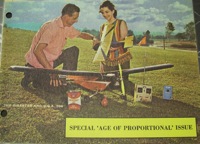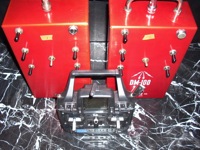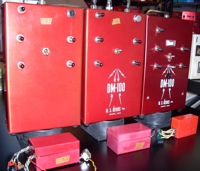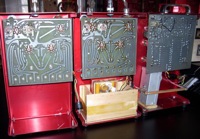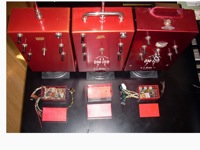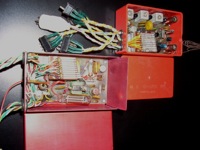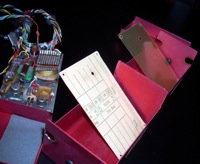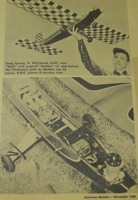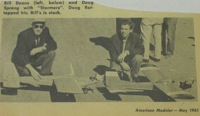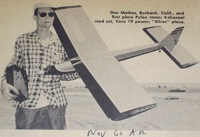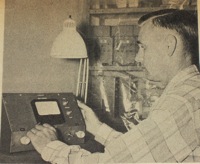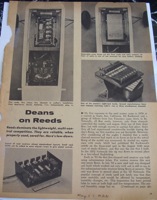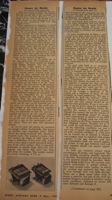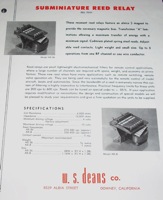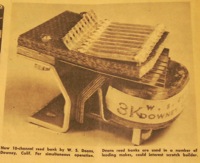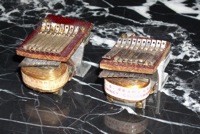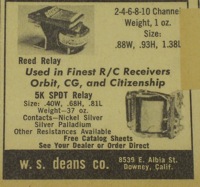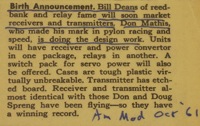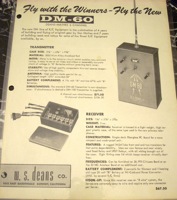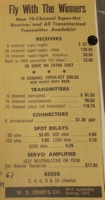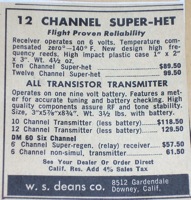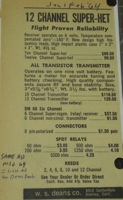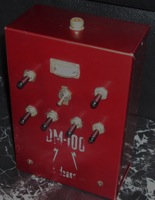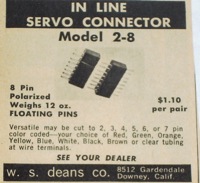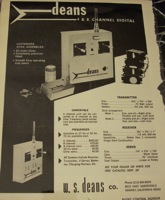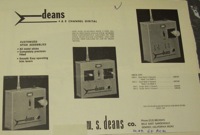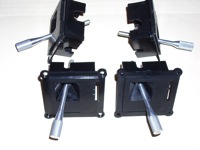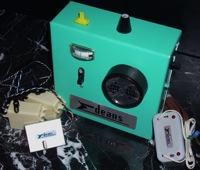Special Exhibit:
First Deans?
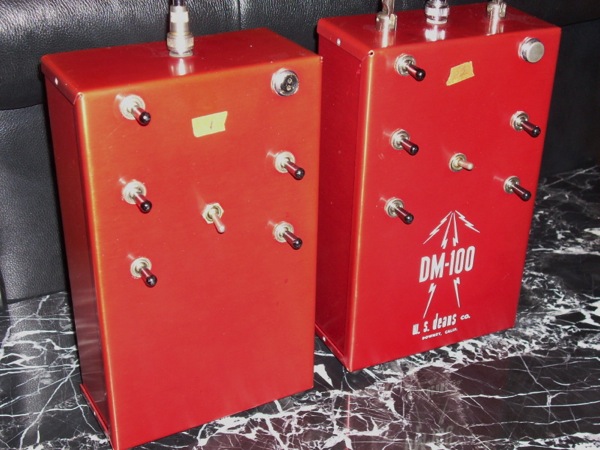
(Click on any of the images on this page to see a larger version)
These are two prototype Deans reed systems made by RC electronics great Don Mathes in 1959 or 1960. W.S. Deans may be the longest running U.S. RC manufacturer ever, and its still in business today. Ironically, these two resonant reed systems were born in the cradle of proportional control—Solidtronics, Van Nuys, California. Solidtronics, under Hershel Toomim, made the first commercially available proportional system, the Space Control, at about the same time. See First Space Control.
While at Solidtronics, Mathes worked on Space Control and turned out the Deans in his spare time. He evidently used Space Control’s labs and shops, probably with permission, since there would have been little adverse competitive impact. Many other companies already made reed radios and Space Control was much more advanced and expensive and really in a market all its own. Mathes kept these prototypes for a few years then gave them to another former Solidtronics employee, Dan Garrabrant, in return for work on the Doug Spreng/Don Mathes Digicon system. See First Space Control for more about Dan and the advent of proportional.
Here is a picture of these “Red Giants” with a modern radio so you can appreciate their scale. Dan Garrabrant says these transmitters and receivers had the masking tape labels #1 and #2 on them since the day he got them from Mathes and Dan never took them off since he ended up never using them. He said Mathes told him they were the first of what would become Deans reed radios and Dan recalls seeing them around the shop back when they both worked at Solidtronics. Deans #1 and #2 are both anodized with the special shade of red used on Solidtronics Space Controls (different from the red color of Deans production models and that used by other manufacturers like Citizen-ship and Logictrol).
Deans #1 and #2 appear to be the first 2 of what became the Deans reed systems, marketed by W.S. Deans Co. starting in late 1961. However, we lack sufficient verification to make this call at this date. Their lineage extends back before these two to earlier reed systems made by Mathes but any earlier examples were probably not red giants in the Deans configuration.
Comparative Differences
Much is revealed by pictures comparing the prototypes with a production model. In each picture we start with #1 on the left, followed by #2 in the middle then the production model on the right. First lets look at the front view:
The most obvious differences include no meter on #1 and #2 and no lettering on #1. Both prototypes began life as 8 channel systems and then the top flipper switch was added when they were expanded to 10 channels. Note how the top switch is too close to the top of the case as if squeezed in on what was an 8 channel layout. Contrast the planned spacing on the production model. In the case of #1, the extra control switch doesn’t even align with those below it. Can you see how it is slightly off to the right?
Both #1 and #2 have a charging jack on the top right which adds symmetry to the layout. Production models had no charging jack (see ads below). The one seen here was retrofitted by the flyer. The prototypes have cases (“cans”) which are slightly larger than the production model and the aluminum used is a much heavier gauge—heavier than we have seen on any transmitter by any manufacturer.
Here is the inside rear view:
At the bottom of the circuit board are 8 tuning stations for each of the 8 channels it was designed for. The 2 above were installed later and separately wired into the circuit.
Here are some side views:
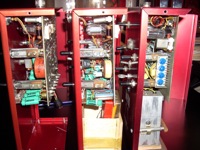 | 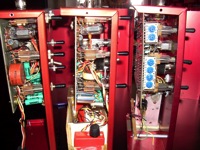 | 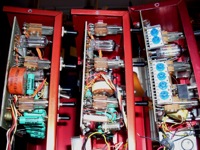 |
These show the progression in trim pots, torroidal coils and other components and how the add-on fifth flipper switch on the prototypes was wired into the circuit since it was not accommodated by the 8 channel PC Board.
Here are the three receivers opened:
Note that #1 is sans relays and #2 is sans everything!
Here is a close-up of the receivers:
Deans reed banks, of course.
And here are the dielectric cards from the bottoms of each prototype:
Note that for #1 Mathes used a Solidtronics employee time punch card! Must have been handy.
Back-To-Back Nationals Wins
Doug Spreng won the 1960 Nationals with the Mathes radio (Nov 60 A.M.):
Here are two more pictures from a subsequent article (April 61 A.M.):
You can see the large, metal- cased receiver, like our prototypes, but there appears to be a different top with a tuning coil access hole in it. However, since every picture from every angle shows the same half circle instead of the full circle required, this may have merely been a sticker or tape or something else other than a hole in the case. The tuning hole on the prototypes is on the bottom of the cases.
Here is a picture of Doug Spreng with Bill Deans and their two “Stormers” (May 61 A.M.):
Here is Don Mathes after winning the pylon event (Nov 60 A.M.):
The caption mistakenly states it is a 4 channel system, but with reeds, 4 switches denote 8 channels. We can’t be sure if the transmitter he’s holding is one of our prototypes. Both would have looked like this one, before they were converted from 8 to 10 channels.
In 1961, Doug Spreng again won the Nationals with a prototype Deans and this time it was labeled a Deans, with the model number DM-100 like #2. The DM stood for Deans-Mathes, and was used on all production models.
W.S.Deans
Bill Deans was a major figure in radio control. Here is a picture of Bill at his factory (Dec 64 A.M.):
In the background are some late model 12 channel Deans transmitters. Bill Deans first flew RC in 1949. After flying the earliest reed systems by Ed Rockwood he developed his own reed bank. Here is a 1957 article by Bill Deans about his early systems (May 57 MAN):
Deans reed banks were so superior that they were incorporated in the reed radios of major manufacturers including Orbit, C.G. (F&M), and Citizen-Ship. They became the leader in their industry.
Here is a brochure for early Dean’s reed banks. Note that they didn’t even have the familiar “W.S. Deans” label at that time. Here is the product announcement for the later 10 channel reed bank (Jan 60 MAN):
And here are sample 8 and 10 channel Dean’s reed banks:
Taking The Plunge—Full Time Manufacturing
When the big aviation company he worked for suffered contract cancellations in 1957, Bill Deans decided to go into RC production full time. In 1958, he added relays to his product line. Like most RC manufacturers, he began modestly, working out of his garage with his wife winding the relay coils. By 1959, Deans had a separate shop with 7 employees, and they were just beginning. Here is an early ad for Deans reeds and relays (Jan 60 A.M.):
In the summer of 1960, Doug Spreng won the Nationals using the 10 Channel Mathes radio which would become the Deans. For some reason, a year passed before production actually began. In the records of the 1960 Nationals, the radio is called a Mathes, not a Deans. It may be Mathes developed his prototype without knowing who would manufacture it, well before striking a deal with Deans. Also, the records indicate Bill Deans flew Orbit and Ace brand reed systems himself at the 1960 Nationals.
At the 1961 Nationals, Spreng won again and this time the transmitter was clearly designated a Deans DM 100. In October, 1961, American Modeler announced that Deans would begin making complete RC reed radios. Here is the “Birth Announcement” for Deans radio control systems (Oct 61 A.M.):
First Ad
In the 1962 Annual Edition of American Modeler (end of 61, beginning of 62), this ad promised Deans’ 6 and 10 channel reed systems would soon be available:
Note the new Deans connector also designed by Mathes. Deans still makes connectors to this day. The March, 1962 edition of American Modeler presented the first advertisement for the new Deans Radios:
The focus here is on the 6 channel, probably to seek a market niche with a low cost, entry-level radio. Although the 6 and 10 channel were advertised together as Deans’ first systems, we believe the 10 channel came first, since the RC industry had already progressed to 8 channels plus at the time the prototypes were designed by Mathes, since our Deans #1 and #2 were 8 channels before they were expanded to 10, and since the 10 channel version was flown in the 1960 Nationals at least a year before production. The 8 channel version was also flown in the 1960 Nationals, but the 6 channel set was not seen at the Nationals until 1961.
Note the drawbacks of the featured 6 channel necessary to keep the price down. It was not only tube based, relayed and regenerative, but also not simultaneous. You could only give one command at a time (e.g. no up elevator along with ailerons or rudder during turns). The more expensive 10 channel version was offered for those seeking simultaneous control.
Here is a brochure for the DM-60 system released around the same time:
Special Features
Among the touted features are the antenna specially made for Deans, the addition of a meter (not common then) to aid tuning and battery checks, and a receiver with a built-in power converter to eliminate the B battery, and a tough, dustproof plastic case.
Soon after, Deans advertised a superhet ten channel and servo amplifiers to convert Bonner Duramite servos to relayless operation and promised an all-transistorized transmitter was coming (Sept 62 A.M.):
This ad illustrates Deans’ practice of placing the relays in a separate box. Flyers with modern relayless servos could buy the receiver alone while others who had Duramites or other unamplified servos could keep their present equipment and purchase the relay case as well. These flyers could avoid the expensive upgrade of their servos and enjoy a second advantage. By placing the relatively heavy relays in a separate case, the odds of receiver crash survival were enhanced. Other manufacturers, like Min-X, followed the same practice.
In December, 1962, Deans advertised a new transistorized 10 channel transmitter which operated on a single 9 volt battery. Deans continued to advertise its full line of 6 and 10 channel reed radios through the Jan/Feb 63 edition of American modeler, including superregen, superhet, tubes, transistorized, simultaneous and non- simultaneous models:
Then, advertising ceased while Deans prepared to roll out a new 12 channel system.
End Of Reeds
Finally, in the Nov/Dec 63 American Modeler Deans ran this ad for the new 12 channel radio:
Here is an actual Deans 12 channel:
The ad was replaced with this larger version in 1964 (Jan/Feb and May/Jun 64 A.M.):
The next Deans ad, and all that followed marked the end of an era. They were for connectors only (Mar /Apr 64 A.M.):
There was no mention of any relays, reed banks or radios whatsoever, as RC development entered the age of proportional and began to leave reeds and relays behind.
Deans Returns With Proportional
After about 4 years (an eternity at this time of rapid RC development), Deans returned to the RC radio business with a line of digital proportional equipment. Here is an early ad for a 2 stick version (Aug 67 RCM) and a later ad including the single stick alternative (Mar 68 RCM):
Their striking green color surprised everyone who had seen only the advertisements. Aside from this, Deans attempted to differentiate their offering in the crowded RC radio field with three features:
1. Special all metal sticks. These were actually modified Bonner gimbals with a much nicer stick and smoother, easier trim adjustment mechanism. Here are some examples, never assembled:
2. Enhanced reliability. On the theory that most radio failures appear during the first few hours of operation, Deans would subject the transmitter and airborne components (hooked up to a special simulator) to eight hours of operation before selling them.
3. A pulse train with two stages of noise clipping, to create a high interference rejection receiver.
Here are actual single and dual stick Deans Proportional Radios:
These radios continued to be sold through 1968, after which Deans produced an innovative car radio with a wheel on front for control. This was a hit with RC car buffs and considered the best in the business. But then a foreign manufacturer came out with a near copy at a much lower price.
The era of Deans RC radios soon came to a close.



